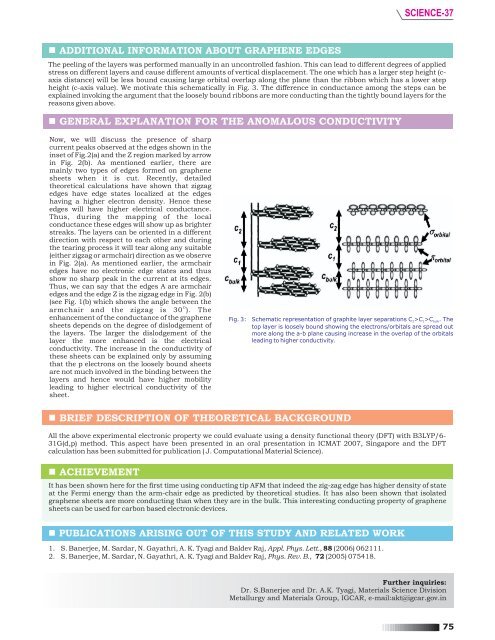Mapping Conductivity of Graphene Sheets using Conducting Tip of ...
Mapping Conductivity of Graphene Sheets using Conducting Tip of ...
Mapping Conductivity of Graphene Sheets using Conducting Tip of ...
You also want an ePaper? Increase the reach of your titles
YUMPU automatically turns print PDFs into web optimized ePapers that Google loves.
SCIENCE-37<br />
ADDITIONAL INFORMATION ABOUT GRAPHENE EDGES<br />
The peeling <strong>of</strong> the layers was performed manually in an uncontrolled fashion. This can lead to different degrees <strong>of</strong> applied<br />
stress on different layers and cause different amounts <strong>of</strong> vertical displacement. The one which has a larger step height (caxis<br />
distance) will be less bound ca<strong>using</strong> large orbital overlap along the plane than the ribbon which has a lower step<br />
height (c-axis value). We motivate this schematically in Fig. 3. The difference in conductance among the steps can be<br />
explained invoking the argument that the loosely bound ribbons are more conducting than the tightly bound layers for the<br />
reasons given above.<br />
GENERAL EXPLANATION FOR THE ANOMALOUS CONDUCTIVITY<br />
Now, we will discuss the presence <strong>of</strong> sharp<br />
current peaks observed at the edges shown in the<br />
inset <strong>of</strong> Fig.2(a) and the Z region marked by arrow<br />
in Fig. 2(b). As mentioned earlier, there are<br />
mainly two types <strong>of</strong> edges formed on graphene<br />
sheets when it is cut. Recently, detailed<br />
theoretical calculations have shown that zigzag<br />
edges have edge states localized at the edges<br />
having a higher electron density. Hence these<br />
edges will have higher electrical conductance.<br />
Thus, during the mapping <strong>of</strong> the local<br />
conductance these edges will show up as brighter<br />
streaks. The layers can be oriented in a different<br />
direction with respect to each other and during<br />
the tearing process it will tear along any suitable<br />
(either zigzag or armchair) direction as we observe<br />
in Fig. 2(a). As mentioned earlier, the armchair<br />
edges have no electronic edge states and thus<br />
show no sharp peak in the current at its edges.<br />
Thus, we can say that the edges A are armchair<br />
edges and the edge Z is the zigzag edge in Fig. 2(b)<br />
(see Fig. 1(b) which shows the angle between the<br />
O<br />
armchair and the zigzag is 30 ). The<br />
enhancement <strong>of</strong> the conductance <strong>of</strong> the graphene<br />
sheets depends on the degree <strong>of</strong> dislodgement <strong>of</strong><br />
the layers. The larger the dislodgement <strong>of</strong> the<br />
layer the more enhanced is the electrical<br />
conductivity. The increase in the conductivity <strong>of</strong><br />
these sheets can be explained only by assuming<br />
that the p electrons on the loosely bound sheets<br />
are not much involved in the binding between the<br />
layers and hence would have higher mobility<br />
leading to higher electrical conductivity <strong>of</strong> the<br />
sheet.<br />
Fig. 3: Schematic representation <strong>of</strong> graphite layer separations C<br />
2>C 1>C bulk. The<br />
top layer is loosely bound showing the electrons/orbitals are spread out<br />
more along the a-b plane ca<strong>using</strong> increase in the overlap <strong>of</strong> the orbitals<br />
leading to higher conductivity.<br />
BRIEF DESCRIPTION OF THEORETICAL BACKGROUND<br />
All the above experimental electronic property we could evaluate <strong>using</strong> a density functional theory (DFT) with B3LYP/6-<br />
31G(d,p) method. This aspect have been presented in an oral presentation in ICMAT 2007, Singapore and the DFT<br />
calculation has been submitted for publication ( J. Computational Material Science).<br />
ACHIEVEMENT<br />
It has been shown here for the first time <strong>using</strong> conducting tip AFM that indeed the zig-zag edge has higher density <strong>of</strong> state<br />
at the Fermi energy than the arm-chair edge as predicted by theoretical studies. It has also been shown that isolated<br />
graphene sheets are more conducting than when they are in the bulk. This interesting conducting property <strong>of</strong> graphene<br />
sheets can be used for carbon based electronic devices.<br />
PUBLICATIONS ARISING OUT OF THIS STUDY AND RELATED WORK<br />
1. S. Banerjee, M. Sardar, N. Gayathri, A. K. Tyagi and Baldev Raj, Appl. Phys. Lett., 88 (2006) 062111.<br />
2. S. Banerjee, M. Sardar, N. Gayathri, A. K. Tyagi and Baldev Raj, Phys. Rev. B., 72 (2005) 075418.<br />
Further inquiries:<br />
Dr. S.Banerjee and Dr. A.K. Tyagi, Materials Science Division<br />
Metallurgy and Materials Group, IGCAR, e-mail:akt@igcar.gov.in<br />
75
















